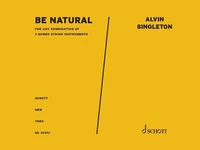La Flora. for chamber ensemble. chamber ensemble. Partition et parties.
Par :Formats :
- Paiement en ligne :
- Livraison à domicile ou en point Mondial Relay indisponible
- Retrait Click and Collect en magasin gratuit
- Réservation en ligne avec paiement en magasin :
- Indisponible pour réserver et payer en magasin
- Nombre de pages68
- Poids0.236 kg
- ISBN978-1-4950-2871-7
- EAN9781495028717
- Date de parution01/01/2016
- ÉditeurSCHOTT
Résumé
Alvin Singleton's La Flora is inspired by the figure of the goddess Flora, a character painted in the mysterious 15th century Botticelli masterpiece La Primavera with its mysterious and sexy gathering of Greek goddesses, gods, and nymphs. Opening and growing mysteriously like some strange spring flowering, this 1983 Singleton work begins with 3 soft, quickly-stated tones that hold in a tense augmented chord.
It is as if we listeners had walked in on something serious ensuing. The listener is already hooked. The 3-note idea, next scalar, seems to blossom into a 4-note idea with the composer extracting large amounts of suspenseful music from them. Instruments enter soloistically, often in long lyrical confessional-sounding lines that are frequently assaulted by acrid percussion instruments, notably maracas.
This drama grows methodically through long tones and well-placed, well-paced repetitions, as the listener waits, still in suspense. Then suddenly at mid-point the work explodes into long passages of tremolandi and repeated figures of aggressive nature. Finally a soft vibraphone solo leads all into a pensive and resigned section closing this brief but effective work. - Carman Moore, 2014 Instrumentation : chamber ensemble
It is as if we listeners had walked in on something serious ensuing. The listener is already hooked. The 3-note idea, next scalar, seems to blossom into a 4-note idea with the composer extracting large amounts of suspenseful music from them. Instruments enter soloistically, often in long lyrical confessional-sounding lines that are frequently assaulted by acrid percussion instruments, notably maracas.
This drama grows methodically through long tones and well-placed, well-paced repetitions, as the listener waits, still in suspense. Then suddenly at mid-point the work explodes into long passages of tremolandi and repeated figures of aggressive nature. Finally a soft vibraphone solo leads all into a pensive and resigned section closing this brief but effective work. - Carman Moore, 2014 Instrumentation : chamber ensemble
Alvin Singleton's La Flora is inspired by the figure of the goddess Flora, a character painted in the mysterious 15th century Botticelli masterpiece La Primavera with its mysterious and sexy gathering of Greek goddesses, gods, and nymphs. Opening and growing mysteriously like some strange spring flowering, this 1983 Singleton work begins with 3 soft, quickly-stated tones that hold in a tense augmented chord.
It is as if we listeners had walked in on something serious ensuing. The listener is already hooked. The 3-note idea, next scalar, seems to blossom into a 4-note idea with the composer extracting large amounts of suspenseful music from them. Instruments enter soloistically, often in long lyrical confessional-sounding lines that are frequently assaulted by acrid percussion instruments, notably maracas.
This drama grows methodically through long tones and well-placed, well-paced repetitions, as the listener waits, still in suspense. Then suddenly at mid-point the work explodes into long passages of tremolandi and repeated figures of aggressive nature. Finally a soft vibraphone solo leads all into a pensive and resigned section closing this brief but effective work. - Carman Moore, 2014 Instrumentation : chamber ensemble
It is as if we listeners had walked in on something serious ensuing. The listener is already hooked. The 3-note idea, next scalar, seems to blossom into a 4-note idea with the composer extracting large amounts of suspenseful music from them. Instruments enter soloistically, often in long lyrical confessional-sounding lines that are frequently assaulted by acrid percussion instruments, notably maracas.
This drama grows methodically through long tones and well-placed, well-paced repetitions, as the listener waits, still in suspense. Then suddenly at mid-point the work explodes into long passages of tremolandi and repeated figures of aggressive nature. Finally a soft vibraphone solo leads all into a pensive and resigned section closing this brief but effective work. - Carman Moore, 2014 Instrumentation : chamber ensemble





